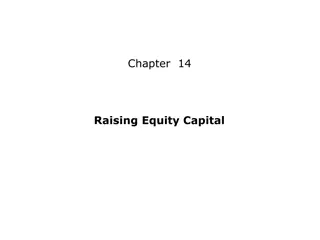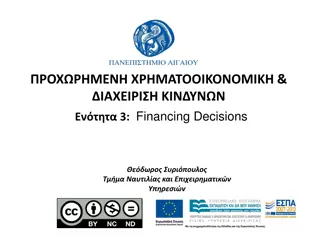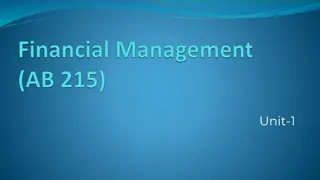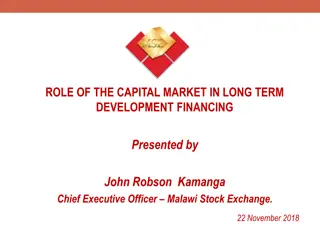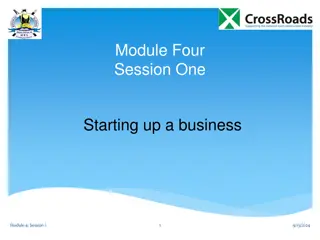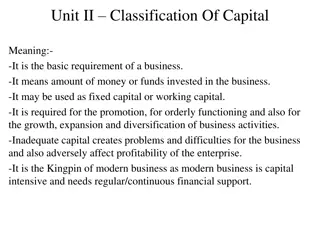Understanding Capital Raising Strategies in Finance
Firms require capital at different stages, which they can obtain through debt financing, equity financing, or a combination of both. Early-stage financing often involves seeking venture capital or other sources of external funding. Venture capitalists invest in high-risk ventures in stages to limit their risks. The process of selling securities to the public involves several steps, including obtaining approval, preparing registration statements, and undergoing examinations by regulatory bodies like the SEC.
Download Presentation

Please find below an Image/Link to download the presentation.
The content on the website is provided AS IS for your information and personal use only. It may not be sold, licensed, or shared on other websites without obtaining consent from the author. Download presentation by click this link. If you encounter any issues during the download, it is possible that the publisher has removed the file from their server.
E N D
Presentation Transcript
RAISING CAPITAL Chapter 15 Reem Alnuaim
Course Roadmap Chapter Topic Focus Exam 15 Raising Capital All 14 Cost of Capital All 9 Net Present Value and Other Investment Criteria All Mid-Term 11 Project Analysis and Evaluation All 16 Financial Leverage and Capital Structure Policy All 10 Making Capital Investment Decision All Mid-Term 17 Dividends Theory All
Introduction All firms must, at varying times, obtain capital. To do so, a firm must either: Borrow the money (debt financing) Sell a portion of the firm (equity financing) or both How a firm raises capital depends a great deal on the size of the firm, its life-cycle stage, and its growth prospects.
Early-Stage Financing and Venture Capital You need what is often referred to as OPM other people s money. Your first thought might be to approach a bank for a loan. You would probably discover that banks are generally not interested in making loans to start-up companies with no assets (other than an idea) Your search for capital would likely lead you to the venture capital (VC) market.
VENTURE CAPITAL Financing for new, often high-risk ventures Individual venture capitalists invest their own money are usually individual VC investors, but they tend to specialize in smaller deals. Venture capital firms specialize in pooling funds from various sources and investing them.
VENTURE CAPITAL To limit their risk, venture capitalists provide financing in stages. At each stage, enough money is invested to reach the next milestone or planning stage. For example, the first-stage financing might be enough to get a prototype built and a manufacturing plan completed. Based on the results, the second-stage financing might be a major investment needed to actually begin manufacturing, marketing, and distribution
Selling Securities to the Public: The Basic Procedure A series of steps is involved in issuing securities to the public: Management s first step in issuing any securities to the public is to obtain approval from the board of directors. Prepare a registration statement and file it with the SEC Securities and Exchange Commission . 1. 2. The SEC examines the registration statement during a waiting period. During this time, the firm may distribute copies of a preliminary prospectus 1.
Selling Securities to the Public: The Basic Procedure 4.The SEC examines the registration statement during a waiting period 5. On the effective date of the registration statement, a price is determined and a full- fledged selling effort gets under way.
Prospectus : A legal document describing details of the issuing corporation and the proposed offering to potential investors. General cash offer : An issue of securities offered for sale to the general public on a cash basis. Rights offer: A public issue of securities in which securities are first offered to existing shareholders. Also called a rights offering. Initial public offering :A company s first equity issue made available to the public. Also called an unseasoned new issue or an IPO. Seasoned equity offering (SEO) : A new equity issue of securities by a company that has previously issued securities to the public Registration Statement: A statement filed with the SEC that discloses all material information concerning the corporation making a public offering.
Underwriters Underwriters: Investment firms that act as intermediaries between a company selling securities and the investing public Services provided by underwriters: Formulate method used to issue securities Price the securities Sell the securities Syndicate group of investment bankers that market the securities and share the risk associated with selling the issue Gross Spread difference between what the syndicate pays the company and what the security sells for initially in the market
A.Firm Commitment Underwriting Issuer sells entire issue to underwriting syndicate The syndicate then resells the issue to the public The underwriter makes money on the spread between the price paid to the issuer and the price received from investors when the stock is sold The syndicate bears the risk of not being able to sell the entire issue for more than the cost Most common type of underwriting in the United States
B. Best Efforts Underwriting Underwriter must make their best effort to sell the securities at an agreed-upon offering price The company bears the risk of the issue not being sold The offer may be pulled if there is not enough interest at the offer price. In this case, the company does not get the capital, and they have still incurred substantial flotation costs Not as common as it previously was
C. Dutch Auction Underwriting Underwriter accepts a series of bids that include number of shares and price per share The price that everyone pays is the highest price that will result in all shares being sold There is an incentive to bid high to make sure you get in on the auction but knowing that you will probably pay a lower price than you bid The Treasury has used Dutch auctions for years Google was the first large Dutch auction IPO
IPOs and Underpricing Determining the correct offering price is the most difficult thing an underwriter must do for an initial public offering. The issuing firm faces a potential cost if the offering price is set too high or too low. If the issue is priced too high, it may be unsuccessful and have to be with- drawn. If the issue is priced below the true market value, the issuer s existing shareholders will experience an opportunity loss when the issuer sells shares for less than they are worth. Underpricing is fairly common. Helps new shareholders earn a higher return on the shares they buy. The existing shareholders of the issuing firm are not helped by underpricing. To them, it is an indirect cost of issuing new securities
WHY DOES UNDERPRICING EXIST? Underpricing tends to be higher for firms with few to no sales in the previous year. These firms tend to be young firms, and such young firms can be very risky investments. Arguably, they must be significantly underpriced, on average, just to attract investors, and this is one explanation for the underpricing phenomenon.
New Equity Sales and the Value of the Firm Seasoned offerings: which are offerings by firms that already have outstanding securities. New long-term financing is arranged by firms after positive net present value projects are put together. As a consequence, when the announcement of external financing is made, the firm s market value should go up. Interestingly, this is not what happens. Stock prices tend to decline following the announcement of a new equity issue, although they tend to not change much following a debt announcement.
Stock prices tend to decline following the announcement of a new equity issue A number of researchers have studied this issue. Plausible reasons for this strange result include the following: 1.Managerial information: If management has superior information about the market value of the firm, it may know when the firm is overvalued. If it does, it will attempt to issue new shares of stock when the market value exceeds the correct value. This will benefit existing shareholders. However, the potential new shareholders are not stupid, and they will anticipate this superior information and discount it in lower market prices at the new-issue date. 2. Debt usage: A company s issuing new equity may reveal that the company has too much debt or too little liquidity. One version of this argument says that the equity issue is a bad signal to the market. After all, if the new projects are favorable ones, why should the firm let new shareholders in on them? It could just issue debt and let the existing shareholders have all the gain. 3. Issue costs: As we discuss next, there are substantial costs associated with selling securities.
The drop in value of the existing stock following the announcement of a new issue is an example of an indirect cost of selling securities. This drop might typically be on the order of 3 percent for an industrial corporation (and somewhat smaller for a public utility); so, for a large company, it can represent a substantial amount of money. We label this drop the abnormal return in our discussion of the costs of new issues that follows.
The Costs of Issuing Securities Issuing securities to the public isn t free, and the costs of different methods are important determinants of which is used. These costs associated with floating a new issue are generically called flotation costs.
THE COSTS OF SELLING STOCK TO THE PUBLIC COSTS OF ISSUING SECURITIES Gross spread : The gross spread consists of direct fees paid by the issuer to the underwriting syndicate the difference between the price the issuer receives and the offer price. Other direct expenses: These are direct costs, incurred by the issuer, that are not part of the compensation to underwriters. These costs include filing fees, legal fees, and taxes all reported on the prospectus. Indirect expenses :These costs are not reported on the prospectus and include the costs of management time spent working on the new issue. Abnormal returns In a seasoned issue of stock, the price of the existing stock drops on average by 3 percent on the announcement of the issue. This drop is called the abnormal return. Underpricing For initial public offerings, losses arise from selling the stock below the true value. Green Shoe option : The Green Shoe option gives the underwriters the right to buy additional shares at the offer price to cover overallotments.
Rights Offerings Issue of common stock offered to existing shareholders Allows current shareholders to avoid the dilution that can occur with a new stock issue Rights are given to the shareholders Specify number of shares that can be purchased Specify purchase price Specify time frame
The Value of a Right The price specified in a rights offering is generally less than the current market price The share price will adjust based on the number of new shares issued The value of the right is the difference between the old share price and the new share price
Rights Offering Example Suppose a company wants to raise $10 million. The subscription price is $20, and the current stock price is $25. The firm currently has 5,000,000 shares outstanding. How many shares must be issued? How many rights will it take to purchase one share? What is the value of a right?
Rights Offering Example Shares issued = 10,000,000/20 = 500,000 Rights to buy one share = 5,000,000/500,000 = 10 Total investment = 10*25 + 20 = 270 Price per share = 270 / 11 = 24.55 Value of a right = 25 24.55 = .45 Buy 10 rights = .45*10 = 4.50 + 20 = 24.50 share price
Dilution Dilution is a loss in value for existing shareholders Percentage ownership shares sold to the general public without a rights offering Market value firm accepts negative NPV projects Book value and EPS occurs when market-to-book value is less than one
Dilution There are several kinds: 1. Dilution of percentage ownership. 2. Dilution of market value. 3. Dilution of book value and earnings per share.
Issuing Long-term Debt Bonds public issue of long-term debt Private issues Term loans Direct business loans from commercial banks, insurance companies, etc. Maturities 1 5 years Repayable during life of the loan Private placements Similar to term loans but with longer maturity Easier to renegotiate than public issues Lower costs than public issues
Example 1 Page 505 Big Time, Inc., is proposing a rights offering. Presently there are 500,000 shares outstanding at 81$ each. There will be 60,000 new shares offered at 70$ each. What is the new market value of the firm A. How many rights are associated with one of the new shares? B. What is the value of a right? C. Why might a company have a rights offering rather than a general cash offer? D.



